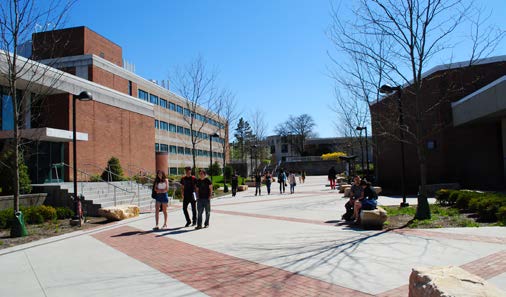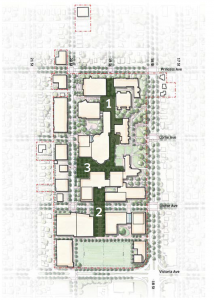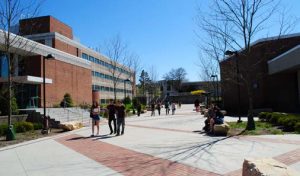The Campus Spine and the George T. Richardson Plaza

There are three substantive plaza spaces in the Open Space Framework. Two define the North-South Spine in its distinct upper and lower portions. The other defines the east-west pedestrian corridor. The upper plaza provides a connection from Princess Avenue to McMaster Hall. It constitutes a tree-lined pathway between the Centennial Auditorium and the Health Studies Complex, transitioning to an open, hard-surfaced plaza space that also functions as the main service corridor for the north campus buildings. The lower plaza provides a generous urban open space and destination for the south campus area, framed by two new buildings on the north side of Louise Avenue. The east-west plaza is very similar to the lower plaza in terms of function, flexibility, and quality of space. It functions as the central east-west pedestrian corridor through the Campus, connecting 20th Street to the Quad open space and to 18th Street.
Upper Plaza — A. E. MacKenzie Plaza (1)
The upper plaza provides a connection from Princess Avenue to McMaster Hall. It constitutes a tree-lined pathway between the Centennial Auditorium and the Health Studies Complex, transitioning to an open hard surfaced plaza space that also functions as the main service corridor for the north campus buildings.
The plaza extends to an enhanced central node that connects the Clark Hall entrance to the library entrance and engages the Quad. The plaza transitions again to a treed landscape passage that defines the edge of the Quad.
The upper plaza provides a sequence of travel experiences from neighbourhood edge into the heart of the Campus and turns what used to be a back door condition into an attractive pedestrian and service corridor.
Policies:
- The north entrance into the plaza should be treated as a gateway with opportunities for signage, art, and enhanced landscaping and lighting.
- There should be clear pedestrian pathway connections and access onto the plaza from each of the buildings that frame the space.
- Enhanced materials such as stone or brick paving should be used to create a more pedestrian character of place.
- Pedestrian-scaled lighting should be used along the length of the plaza.
- The service area must continue to allow for service and loading functions, but should be coordinated between buildings, and regulated by day and time restrictions.
- The plaza should be designed as an attractive place to look upon as it will be viewed from the pedestrian passageway above.
Lower Plaza — Healthy Living Centre Plaza (2)
The lower plaza provides a generous urban open space and destination for the south campus area. It is framed by two new buildings on the north side of Louise Avenue. These buildings are the redeveloped student residence sites. On the south side of Louise Avenue, the plaza is framed by the Healthy Living Centre and a new south campus building. This plaza engages Louise Avenue, and creates a bridge between mid and south campus. It provides opportunities to engage the street to host large events that encompass both plaza and street.
The lower plaza provides an opportunity to animate the South Campus Quadrant, providing opportunities for passive recreation to complement the more active field activities. The width of the plaza is generous enough to accommodate seating, landscaping, water and art features.
Policies:
- The lower plaza should be designed as a signature space for the University, using high-quality paving materials, furnishings, and design.
- The plaza should be designed as a primarily hard surfaced area, but include trees and landscaping for shade and shelter and to beautify the space.
- The plaza should be furnished with seating, landscaping, and bike racks.
- Provide pedestrian-scaled lighting to create a well-lit and safe open space to be enjoyed during the evening hours.
- The design should provide a flexible forum for a variety of passive activities such as sitting, lingering, and reading. It should accommodate uses such as an outdoor market, academic displays, and outdoor exercise related to the Healthy Living Centre.
- The at-grade use of all new buildings should provide “eyes on the plaza”, animate the space, and provide internal and external pedestrian linkages between the plaza and buildings.
- The plaza should be designed to be viewed and appreciated from the interior building spaces.
- The plaza should be an opportunity to locate indigenous art, temporary art installations, or the display of University activities.
- There should be clear and unobstructed views through the plaza, which can be terminated by landmark architecture, art or significant open spaces.
- The plaza should provide spill out eating space for the Harvest Hall during warmer seasons.
The East-West Plaza — George T. Richardson Plaza (3)
The east-west plaza is very similar to the lower plaza in terms of function, flexibility, and quality of space. It functions as the central east-west pedestrian corridor through the Campus, connecting 20th Street to the Quad and to 18th Street. The plaza is framed by two new buildings at the 20th Street entrance. These buildings are intended to animate the plaza and draw activity to the space.
Policies:
- All policies for the lower plaza apply to the east-west plaza in terms of quality, flexibility, function, use, animation, and visual and physical accessibility of the space.
- All policies for the lower plaza apply to the east-west plaza in terms of materiality, furnishing, lighting, landscaping and beautification of space.
- All policies for the lower plaza apply to the east-west plaza apply in terms of the building to open space relationships.
- The design of the plaza’s west face should be attractive and welcoming in order to draw the westerly neighbourhood into the Campus.
- The westerly portion of the plaza should be designed as a landmark and gateway open space, in keeping with the Quad landmark open space at the plaza’s east end.


